Jump to:
Previous issue | All issues | Next issue
President’s Message, June 2006
Annual General Meeting and Emerson Tour, May 27
Judith Hudson Beattie Receives the Douglas Kemp Award
Margaret McWilliams Awards 2005
Centennial Organization Awards 2006
Free Manitoba Record Society Books
York Factory National Historic Site
The Manitoba Agricultural Hall of Fame
Inglis Elevators National Historic Site Near Completion
 On May 27 a few members of the Manitoba Historical Society went by bus to Emerson, where we had a fine lunch and our annual general meeting, followed by a bus coach tour of “historic” Emerson. We almost didn’t manage the bus tour, but thanks to the presence of a qualified bus driver on the tour and his access to a bus, everything worked out well in the end. A Miracle of Coincidence, the theologians would call it.
On May 27 a few members of the Manitoba Historical Society went by bus to Emerson, where we had a fine lunch and our annual general meeting, followed by a bus coach tour of “historic” Emerson. We almost didn’t manage the bus tour, but thanks to the presence of a qualified bus driver on the tour and his access to a bus, everything worked out well in the end. A Miracle of Coincidence, the theologians would call it.
Wayne Arseny, dressed in an authentic woolen Royal North West Mounted Police uniform complete with hat, was our guide. We could tell that the outfit was authentic because of the amount of sweat being generated on Wayne’s brow; wool is not something one would normally wear in the town which that very day was the hot spot of Canada.
Although I had driven to Grand Forks dozens of times, I had never gone off the highway to have a look at the village or town of Emerson. Seeing the town was a pleasant surprise. Home of 700 people, Emerson has a number of historic houses from the early days, when it was supposed to be the gateway to Manitoba. It also has a fine RNWP fort, and some committed citizens like Wayne to keep it on its toes. The tour of Emerson (and its neighbouring town West Lynn) simply has to be undertaken with someone like Wayne, who can explain to the visitors what they are seeing and something of what lies beneath the surface.
There are literally dozens of little towns in Manitoba like Emerson, with a variety of dusty historical memories and glimpses of other pasts. Some of them have been the subjects of growing up memoirs by former inhabitants, others have not. All remind us of a way of life that is past disappearing and which can be recovered today only with increasing difficulty. Helping to keep the past alive is part – but only part – of the task of the Manitoba Historical Society. But it is something worth doing, and each of us makes a contribution almost every day.
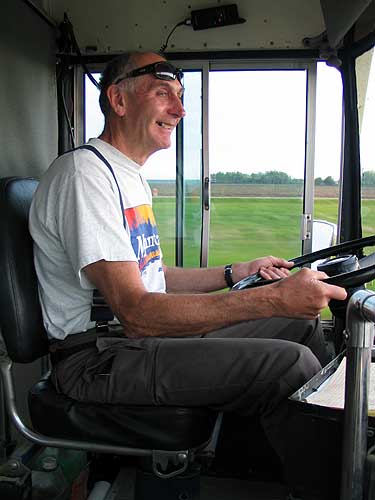
Our friendly driver, MHS member Doug Belcher
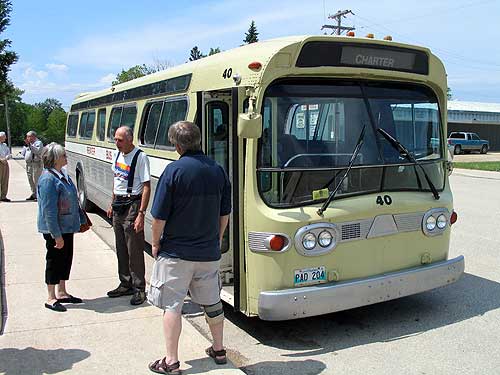
The tour bus arrives in Emerson
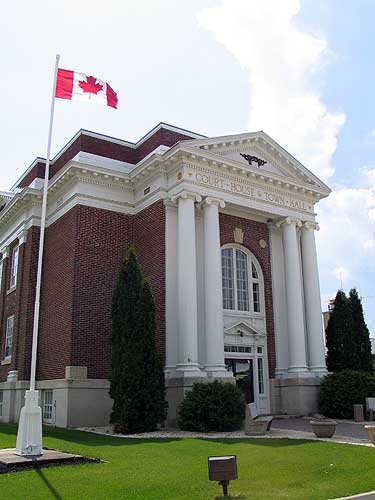
The historic Emerson court house and town hall
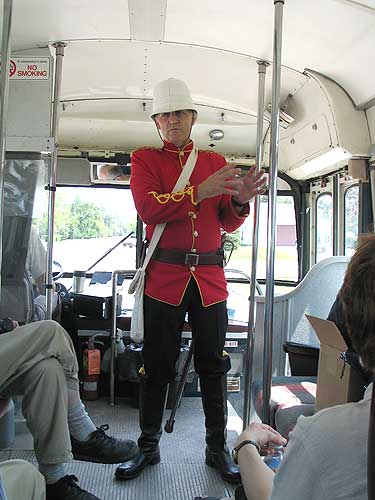
MHS Council member Wayne Arseny, dressed in an NWMP officer uniform, led a bus tour of Emerson.
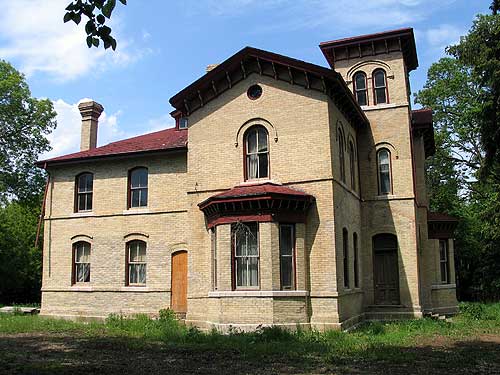
William Newton Fairbanks House, Emerson
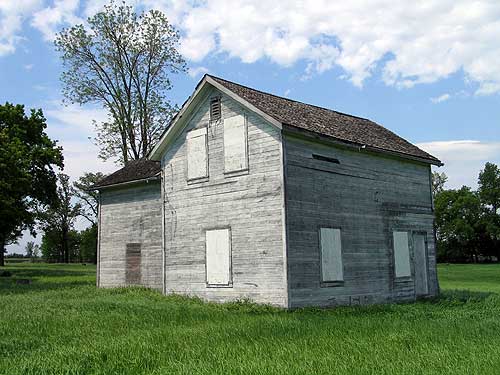
Officers residence at Fort Dufferin near Emerson
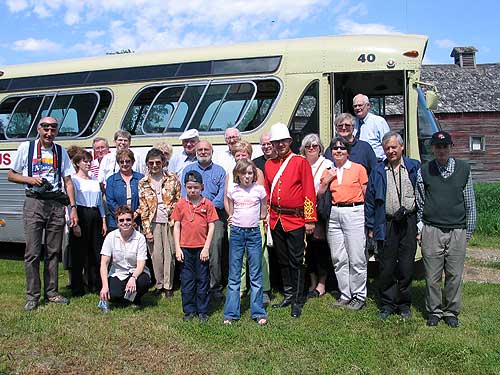
MHS group at Fort Dufferin
Cliff Logan
William Neville
David & Maureen Wayne
Transportation, Heritage & Technology Centre
Tracy Hunt
MHS General Operations
Doreen Thorlacius
Mr. & Mrs. H. A. Skene
Mardie Law
Fern Morris
MHS Ross House Museum
William Neville
Norman Larson
Winnipeg Foundation, Community Grants
Culture, Heritage & Tourism, Heritage Grants Program
Jewish Foundation of Manitoba
The Dalnavert Garden
“Oh, give us pleasure in the flowers today….” Robert Frost “ A Prayer in Spring”
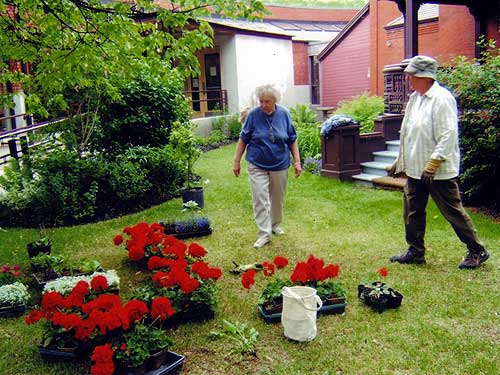
Kathleen Campbell organizes a dedicated group of volunteers who develop and maintain the Dalnavert gardens
The Dalnavert property is not large enough to feature the secluded areas, winding pathways and the arbours associated with a true Victorian garden. However, the recently acquired land has allowed for the expansion of original flowerbed space, additional planting areas and a larger lawn. 61 Carlton is now seen as standing proudly in its own grounds.
The planning and layout of the garden have been governed by the programs, events and requirements of Dalnavert as a museum. Public and school tours demand easily negotiated access and information relevant to each area. Garden tours will feature specific interest points combined with general information on the Victorian garden. The wildflower garden, for example, will provide an interesting history of native plants, and the aromatic and medicinal properties of herbs will enhance discussion on today’s interest in their culinary uses. The museum solarium, with its array of indoor plants, falls under the heading of window gardening. By the 1870s, advances in home lighting, heating and ventilation allowed for indoor plants and thus began the Victorian passion for trailing vines, palms, and a positive mania for ferns of all descriptions. The same technical advances included the maintenance of a greenhouse, and flowering plants were cultivated for both home and garden.
In the verandah area visitors will learn of the Victorian concept of the house and garden acting as a single unit; the landscaping of the garden at one with the architecture of the house. Victorians referred to their gardens as house grounds, an extension of the indoors where the garden became a summer parlour and a place for social entertaining. They delighted in garden parties and lawn games such as croquet. Afternoon tea was served in the shade and coolness of the verandah. Dalnavert has a perfect verandah for both relaxation and social occasions, and will be furnished with wicker seating, potted plants and hanging baskets. Interestingly, a recent article in the Free Press on the popularity of gardening includes the following, “Homeowners are also blurring the lines between indoor and outdoors, wanting to make their gardens an extension of their homes.”
Dalnavert’s garden is planted according to what was available in Winnipeg circa 1895: Solomon’s Seal, daisies, Sweet William, Bleeding Heart, are among the familiar plants and shrubs of the period. Towards the end of the era, Victorian preference for the formal, tightly grouped plantings gave way to nature and garden landscapes gracefully combined annuals with perennials, shrubs and vines and the trees that shade our streets and gardens. Flowers were planted in drifts, and it is in this more natural manner that Dalnavert’s garden has been created, giving flow to design and a softer blending of colour. Perennials and shrubs provide the background or framework of the garden. The annuals accessorize and bring an abundance of variety to the predominantly perennial borders. The cosmos, larkspur, pansies and other familiar flowers of summer add seasonal colour to dark green foliage.
The work is being done by a six-member committee of volunteers, Some are new to Dalnavert drawn by their interest and love of gardening. Others are long-time museum volunteers but also keen gardeners. Mention must also be made of the support Dalnavert has received from garden centres, whose owners have generously donated and shown great interest in the project. The volunteers have raided their own gardens on behalf of Dalnavert. Also, two most welcome contributions, one of plants and one financial were received from members of the Society last fall. The need for further donations is still with us.
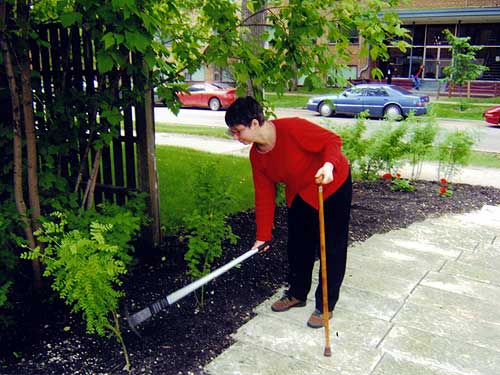
As we work at the planting it is rewarding to note how many people now stop to look at the garden and ask about Dalnavert. It is hoped that the garden will give pleasure to all who visit the Museum, either to take a tour or to just enjoy a restful oasis a few steps from the traffic and activity of Broadway.
Submitted by the Garden Committee – Peggy Broek, Helen Gyorgy, Lorraine Ian, Michelle and Timothy Desourdy, Kathleen Campbell. Assistance in the garden was also provided by Victor Sawelo, manager of Ross House Museum.
Dalnavert Garage Sale
The annual Dalnavert garage sale was held on May 20th in partnership again this year with the Ukrainian Labour Temple in their hall at 591 Pritchard Ave. The event was a great success and the sale netted Dalnavert over $1100. Thanks go out to those who donated items and to Victor Sawelo, Linda Meckling and Marg Kentner for their time setting up prior to and working on the day of the sale
Dalnavert Volunteer Tea
Dalnavert volunteers past and present attended a tea in the Visitors Centre on June 11. Gordon Goldsborough thanked the volunteers for their dedicated service over the years. Museum executive director Linda Neyedly presented a pin to Lesley Hoffman for 25 years service.
Dalnavert Lecture Series
Dalnavert concluded its lecture series on April 26 with “Man and History in the Digital Age” The speakers were MHS president Gordon Goldsborough, Professor John Lehr of the University of Winnipeg and Larry Laliberte, GIS Librarian at the University of Manitoba. Larry Laliberte, pictured below, showed what can be done by combining an historical map of the Wolseley expedition and the modern tool, Google Earth.
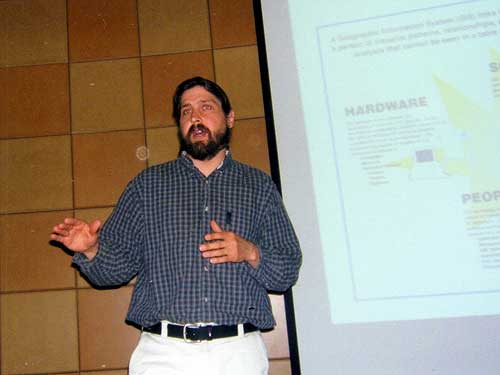
Joe Zuken Plaque Unveiling at Ross House
On July 1 at Ross House MHS is having an expanded Canada Day program in association with the Zuken Memorial Association. A plaque will be unveiled commemorating the contributions of the late Joe Zuken (1912-1986) as a long-serving member of the Winnipeg School Board (1941-1961) and the Winnipeg City Council (1961-1983). The plaque will be unveiled at 11:35-by Lieutenant Governor John Harvard and Joe Zuken’s widow, Clara Zuken. Professor Bill Neville, a former colleague of Mr. Zuken on City Council will give a memorial address. After the unveiling, there will be excerpts from the musical Strike written and directed by Danny Schur.
The barbecue will begin at noon followed by birthday cake. All are welcome to enjoy this fun, *free* event at Ross House.
Ross House Staff Summer 2006.
Left-right: Victor Sawelo, Ross House Manager, with Derek Zorniak and Daniel Schulz
Simon Lucy is chair of the Ross House management committee. Ross House is open 11 am to 5 pm, Wednesday through Sunday, June 1 to August 31
Click here for an up-to-date list of Centennial Farm recipients.
Lieutenant Governor John Harvard presented the Douglas Kemp Award to Judith Hudson Beattie at the MHS awards ceremony at St. John’s College on April 23. The award commemorates Douglas Kemp president of the Society from 1959 to 1961.
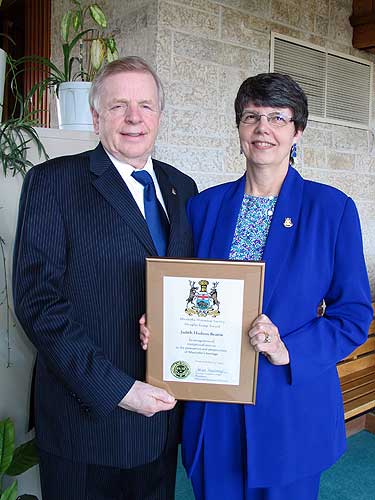
Lieutenant-Governor Harvard presents the 2006 Douglas Kemp Award to Judith Hudson Beattie.
Judy has served the Society in a volunteer capacity for many years. She has been on the executive as vice president and later as secretary and is a member of the MHS council. She initiated the Manitoba Centennial Business Award and continues to serve on the selection committee. She is also chair of the Young Historians Committee. She recently initiated the establishment of the MHS Book Club. Judy is an author and a professional archivist. For several years she was Keeper of the Hudson Bay Archives.
2005 Margaret McWilliams Award recipients with Lieutenant-Governor Harvard. Left-right: Lynne Skromeda, Alvin Esau, Jim Blanchard, Hon. John Harvard, Maurice Mierau, Birk Sproxton.
Category |
Title |
Author |
Publisher |
Scholarly history |
The Courts and the Colonies: The Litigation of the Hutterite Church Disputes |
Alvin J. Esau |
University of British Columbia Press |
Institutional history |
Memoir of a Living Disease: The Story of Earl Hershfield and Tuberculosis in Manitoba and Beyond |
Maurice Mierau |
Great Plains Publications |
Local history |
Phantom Lake: North of 54 |
Birk Sproxton |
University of Alberta Press |
Local history (honorable mention) |
Au Pays de Gabrielle Roy |
Annette Saint-Pierre |
Editions des Plaines |
Historical fiction |
Dear Canada: Turned Away |
Carol Matas |
Scholastic Canada |
Popular history |
Winnipeg 1912: Diary of a City |
University of Manitoba Press |
|
Popular history (honorable mention) |
A View From the Ledge: An Insider's Look at the Schreyer Years |
Herb Schultz |
Heartland Associates |
Audiovisual |
Ken Leishman: The Flying Bandit |
Jamie Brown and Lynne Skromeda |
Frantic Films |
Also honored were past recipients of the McWilliams awards, several of whom attended the ceremony on 23 April with their award-winning publications.
Previous McWilliams award recipients with Lieutenant-Governor Harvard and award ceremony emcee Ron Robinson: Left-right: John Warms, Giles Bugailiskis, Hon. John Harvard, J. M. Bumsted, Doug Whiteway, Barb Huck, Kevin Longfield, Francis Russell, Ron Robinson.
Lieutenant-Governor Harvard with Abe Arnold, past recipient of two McWilliams awards.
These awards were presented by Lieutenant-Governor Harvard at a ceremony on 23 April:
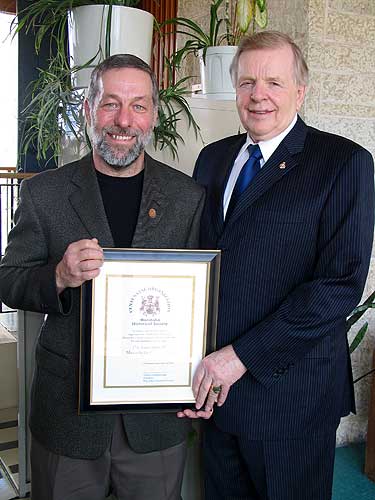
Les McLaughlin
Association of Manitoba Land Surveyors, 1881
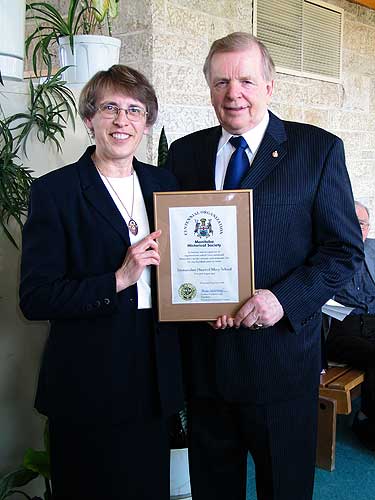
Sister Anne Pidskalny
Immaculate Heart of Mary School, 1905
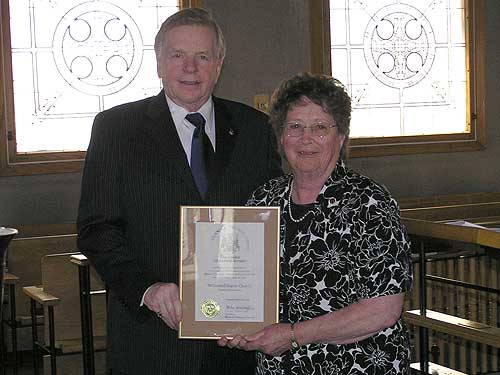
Gwen McClement
Carman Health Auxiliary, 1904
Ray Henschell
Whiteshell Baptist Church, 1902
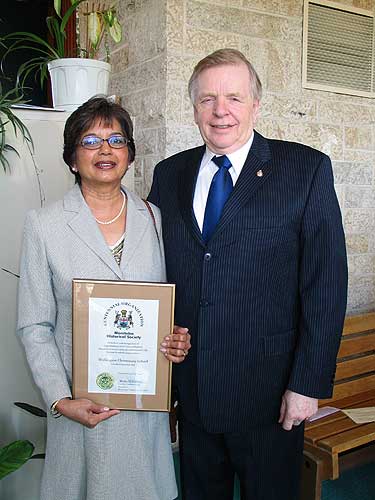
Angeline Ramkissoon
Wellington Elementary School, 1898
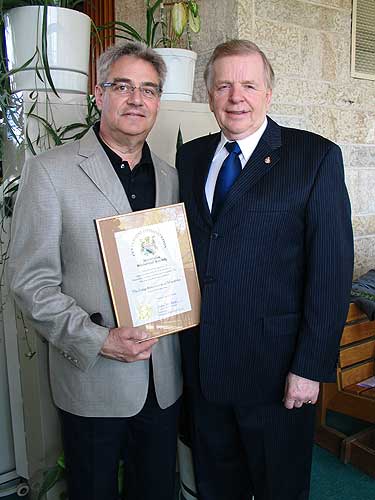
Dr. Frank Hechter
Lung Association of Manitoba, 1904
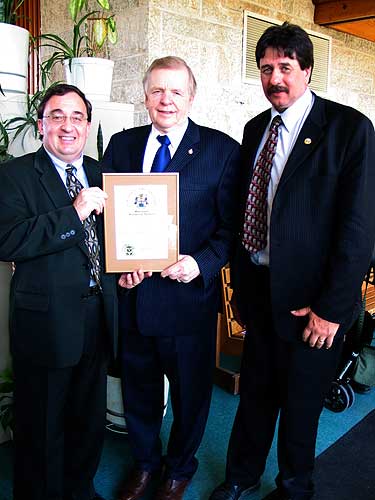
Joe Masi (left) and Garry Wasylowski (right)
Association of Manitoba Municipalities, 1905
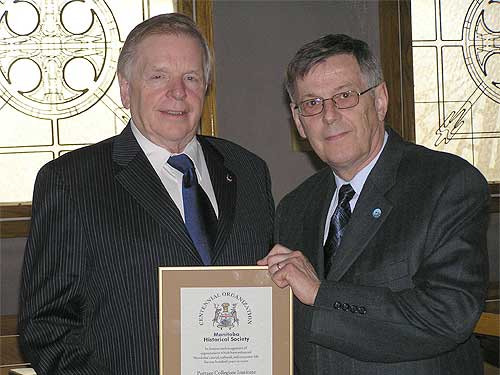
Dennis Hallick
Portage Collegiate Institute, 1895
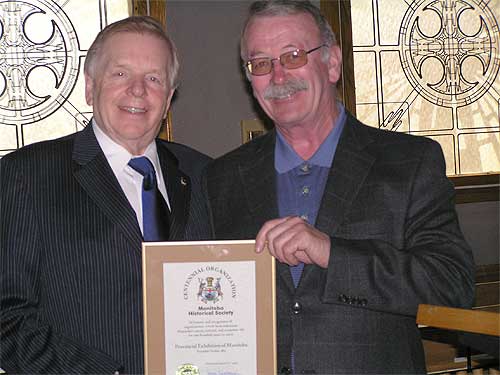
Jim Ferguson
Provincial Exhibition of Manitoba, 1882
In honour of Manitoba Day, May 12, 2006, The Association for Manitoba Archives is formally launching its new web exhibit, “Recorders of Community: The Archival Legacy of the Red River Settlement Churches 1818-1870”. The exhibit is now viewable on the AMA website at www.mbarchives.mb.ca. Click on the church door in the “What’s New” box.
Churches were central to the lives of settlers in this remote fur trade community on the banks of the Red and Assiniboine rivers. Archival documents left by the churches and their parishioners reveal much about that now vanished society.
One viewer describes this exhibit as “like going through the contents of an interesting old trunk”. Interactive maps with clickable icons show the settlement as it was in 1825, 1855 and 1870. Letters and diaries of missionaries and parishioners are both viewable and readable. Viewers learn how stone and frame church buildings were painstakingly built out of local materials. Background information gives the historical context to documents and the exhibit is illustrated with maps, photographs, drawings and paintings. Characters like the multi-talented stonemason and carpenter Samuel Taylor and the tough and resourceful Father Georges-Antoine Belcourt come alive through their letters and diaries.
The Association for Manitoba Archives preserves the heritage of the people and institutions of Manitoba by improving the administration, effectiveness and efficiency of the Province’s archival systems. This exhibit is part of the AMA’s ongoing effort to make Manitoba’s archival resources more accessible to the public.
For further information contact:
Catherine Macdonald
Association for Manitoba Archives
Phone: 204-783-9456
Fax: 204-786-7633
Email: catlogan@shaw.ca
Copies of several books published by the Manitoba Manitoba Record Society are available to MHS members free of charge. Available titles are listed in the current issue of Manitoba History. Information on how to obtain copies is also included. For further information contact Gordon Goldsborough in August at 204-474-7469 or email ggoldsb@cc.umanitoba.ca.
Giving the Past a Future:
Do You Have Something to Say?
Operated continuously between 1684 and 1957, York Factory, near the mouth of the Hayes River on Hudson Bay, was one of the oldest and most important fur trade establishments of the Hudson’s Bay Company. It was also a large, vibrant community, known as Kihci-wâskâhikan in the Cree language. Today, York Factory National Historic Site is heritage at risk, threatened with loss from riverbank erosion, permafrost decay and vegetation encroachment.
York Factory 1923 (National Archives of Canada)
Riverbank erosion at York Factory. The Hayes River is at high tide. The Depot building is to the left.
Photo: K. Skaftfeld
An earlier article, “York Factory National Historic Site of Canada: Planning the Future for a Place with a Momentous Past” (Manitoba History No. 48) announced the beginning of a management planning program by Parks Canada to direct the protection, interpretation and appropriate use of this important place. After more than a year of study and consultation with stakeholders and interested public, a proposed management plan will be soon available for public review and comment. Once the public review is completed and comments considered, the plan will be submitted this fall to the Minister of Environment for approval and will be the guiding accountability document for managing York Factory National Historic Site.
The proposed management plan offers direction for stabilization of the riverbank, archaeological monitoring and salvage, permafrost research, protection of the massive Depot building and the cemetery, managing the important artifact collection, improved interpretation of York Factory’s many stories both on-site and through the Internet, and creating a meaningful and memorable visitor experience.
To receive a copy of the proposed plan and provide your comments, please contact Kevin Lunn at 204-983-3179 or e-mail MB.Plan@pc.gc.ca.
From Kevin Lunn, Parks Canada
There is a homecoming planned for Gilbert Plains July 10-16 2006. The town of Gilbert Plains is 100 years old and the RM of Gilbert Plains is 105 years old. There is a joint celebration planned with a week of activities. There is a new local history book being published to coincide with the homecoming. Contact Ron & Sharon Basaraba 204-548-2240 re history book.
The Boissevain centennial and the 125th anniversary of the Rural Municipality of Morton will be held on July 28, 29 and 30.
Have you ever wondered why Transcona is known for its pink flamingoes and who that gentleman on Regent Avenue is who greets everyone by tipping his hat? Also, why was the railway such an important part in Transcona’s history and how did Transcona earns its nickname as “The Park City”? These are questions that the Transcona Historical Museum (THM) is set to answer in its newest exhibit: “ICONS and IMAGES” of Transcona, Manitoba. The museum’s new exhibit opened June 1 and runs until March 2007. Summer hours are Monday to Saturday from 10 to 4. For more information, please visit the website www.transconamuseum.mb.ca
If you would like more information about this exhibit or the Transcona Historical Museum, please call (204) 222-0423 or email Transcon@istar.ca.
Operation Dialogue is a charitable organization that was founded with the intention of making Canadians more aware of "What it means to be a Canadian" The current project is an online tool and database that will allow people to publish information, the story, pictures, audio, video etc. about a person who they believe to be of interest to other Canadians. It is not intended for professional historians but rather as a way for others to submit things that might otherwise be lost. Please take a look at the website and if you know of anyone or any schools that might be interested please pass the URL along: www.operation-dialogue.com/e/ac/index.html
For more information contact:
Judith Anderson
Director of Programming, Operation Dialogue, 33rd Floor, T.D. Tower,
66 Wellington St W. P.O. Box 50
Toronto, Ontario, M5K 1E9
(416) 364-8863
Fax (416) 367-8094
Community Heritage Manitoba is a province-wide association of municipal heritage advisory committees (or MHACs). These committees are established by municipal councils to advise them on community matters. The goal of community heritage Manitoba is to support member MHACs in theur efforts to identify, protest and interpret the heritage of their communities. Web Page: www.communityheritagemanitoba.ca
A 126-year old barn was moved from the corner of Highway 52 and Reichenbach Road (just west of Mitchell where it was built in 1885) to the Mennonite Heritage Village. The 80-by-38-ft. building was constructed within the first years of Mennonite settlement on the East Reserve which began with the immigration in 1874. It will be attached to the Waldheim House which was also built in that era (probably about 10 years earlier than the barn). The barn was constructed by Peter Peters, the son of Jakob Peters who was the first Obershcultz or mayor on the East Reserve. Peters was also one of the “scouts” who travelled to Manitoba from Ukraine one year ahead of the immigrants to survey the land for settlement.
The RM of Hanover covered the $20,000 moving costs while the costs of restoration will be picked up by people interested in preserving the barn, including some members of the Peters clan. Plans are to bring the barn back to what it was, replacing the livestock stalls, redoing the siding where necessary and thatching the roof, which currently has cedar shingles on one side and asphalt on the other. The plan is to re-thatch the Waldheim House at the same time.
The Dufferin Historical Society in Carman is reprinting the book, Carman & Dufferin: Recollection of an Eyewitness written by former Carman mayor Thomas Kernighan in 1923. The book, renamed The Brightest Jewel, will sell for $20 with the profits going to the Dufferin Historical Museum. For more information call Trish Aubin at 204-745-6790 or Nedra Burnett at 204-745-3058.
The Carberry News-Express reports that preparations are underway for the 125th Anniversary celebrations in Carberry in early July 2007. A history book is being written and over 200 photos have been scanned and catalogued so far. People who intend to send in family histories should do so as soon as possible.
At the Swan Valley Historical Museum in Swan River a plaque was unveiled on May 28 to commemorate Gertrude (Twilley) Richardson who was instrumental in organizing the first “Women’s Suffrage Society” in Manitoba on March 22, 1912 which survived until women got the vote in 1917. The Star and Times reports that the first suffrage society was at the Roaring River School District just east of Swan River. A week after the first suffrage society was formed, Nellie McClung decided to include “suffrage” in the mandate of the Political Equality League to which she belonged. A book by Barbara Roberts, A Reconstructed World, chronicles Richardson’s life. Richardson wrote many articles and delivered speeches throughout the Swan Valley and other parts of Manitoba as an advocate of women’s suffrage. Roberts also explains why health problems prevented Richardson from getting the recognition that she deserved.
Plan a summer adventure exploring the routes you’ll find along Manitoba’s historic Red River. Self directed itineraries for nineteen walking, paddling, cycling and driving tours are presented on this interesting web site: www.routesonthered.ca/fun
The Manitoba Agricultural Hall of Fame Induction Service will be held on Thursday, July 20, 2006 at 1:30 at William Glesky Centre, 11 – 2nd St. N.E. in Portage La Prairie. A reception will follow at the Herman Prior Centre across the parking lot. The five Manitobans honoured this year are:
Allan Sawchuck, project manager writes in the Spring 2006 newsletter: “To date we have restored the five elevators, which included raising the elevators, pouring new concrete slabs, crib replacement and repairs, new siding on most of the elevators and new shingles and roof repair. Four of the five annexes are complete except for some roof repair and painting on the north National annex. We also have the UGG annex to restore. The four offices have been completed. Water and sewer have been brought in to the Paterson office and elevator and all overhead wiring has been installed underground. We operate a gift shop in one of our offices and an interpretive centre in the Paterson elevator. We are presently working on having the Reliance elevator operational for use on special occasions.” Funding has come through from individuals, government, foundations and organizations in recent years to make the restoration a reality.
Everyone is invited to come to the grand opening celebration on August 12. There will be farm hobbyist displays, kids’ carnival, lunch barbecue, evening supper, beer gardens, old time band, horse rides. Hopefully the Reliance Elevator leg will be operating to demonstrate unloading grain.